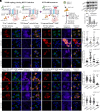Mechanistic insights into dengue virus inhibition by a clinical trial compound NITD-688
- PMID: 40153462
- PMCID: PMC12002330
- DOI: 10.1073/pnas.2426922122
Mechanistic insights into dengue virus inhibition by a clinical trial compound NITD-688
Abstract
Dengue, caused by the dengue virus (DENV), presents a significant public health challenge with limited effective treatments. NITD-688 is a potent panserotype DENV inhibitor currently in Phase II clinical trials. However, its mechanism of action is not fully understood. Here, we present the molecular details of how NITD-688 inhibits DENV. NITD-688 binds directly to the nonstructural protein 4B (NS4B) with nanomolar affinities across all four DENV serotypes and specifically disrupts the interaction between NS4B and nonstructural protein 3 (NS3) without significantly changing the interactions between NS4B and other viral or host proteins. NS4B mutations that confer resistance to NITD-688 reduce both NITD-688 binding to NS4B and disruption of the NS4B/NS3 interaction. Specifically, NITD-688 blocks the interaction of NS3 with a cytosolic loop within NS4B. This inhibits the formation of new NS4B/NS3 complexes and disrupts preexisting complexes in vitro and DENV-infected cells, ultimately inhibiting viral replication. Consistent with this mechanism, NITD-688 retains greater potency in cellular assays with delayed treatment compared to JNJ-1802, another NS4B inhibitor that has been studied in Phase II clinical trials. Together, these findings provide critical insights into the mechanism of action of NITD-688, facilitating the development of novel flavivirus NS4B inhibitors and informing future clinical interventions against DENV.
Keywords: DENV; NITD-688; NS4B; antiviral; flavivirus.
Conflict of interest statement
Competing interests statement:D.B., S.A.M., and C.S. are employees of Novartis and may receive stock. UTMB has filed a patent application entitled “Stable reporter flavivirus” (application number US17/412,900) and P.-Y.S. and X.X. are the co-inventors.
Figures





References
-
- The L., Dengue: The threat to health now and in the future. Lancet 404, 311 (2024). - PubMed
-
- Wilder-Smith A., Ooi E.-E., Horstick O., Wills B., Dengue. The Lancet 393, 350–363 (2019). - PubMed
-
- World Health Organization, Global Strategy for Dengue Prevention and Control 2012–2020 (World Health Organization, 2012).
MeSH terms
Substances
Grants and funding
LinkOut - more resources
Full Text Sources
Medical

